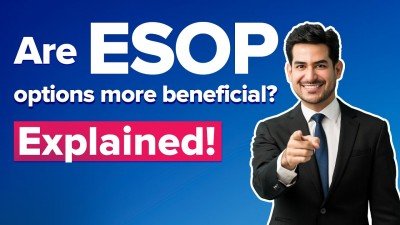
Types of ESOPs: Exploring Benefits for Employees and Employers
Posted By: Blog

The quest for exceptional talent has become a full-fledged war in the corporate world. Every company is actively seeking out the most brilliant individuals to propel their success, all while desiring their employees to remain loyal for a considerable period. However, this becomes quite challenging in an environment where numerous opportunities exist and individuals frequently switch jobs at their discretion. Therefore, employers and companies must devise innovative strategies to not only attract the best brains but also ensure their long-term commitment.
Welcome to the realm of employee stock options or ESOPs for short. In this blog, we'll uncover the essence of ESOP and unveil the secrets to maximizing its potential if you are offered this option. ESOP, as it's commonly referred to, is an agreement between an employer and employee, granting valuable equity-related benefits as a token of appreciation for accepting the employment contract.
Employee Stock Ownership Plan (ESOP)
Additionally, it states that if the employee stays with the company for a reasonable duration, they can unlock the equity valuation designated to them. This serves as a broad explanation of ESOP. To put it simply, ESOP is an arrangement in which the company utilizes equity or a derivative of equity to provide extra benefits to the employee. This encourages the employee to view their commitment to the company in a more comprehensive manner, rather than just a typical employment agreement.
To accomplish this, employers usually offered employees either equity stock or an option to be vested in the company after a specific duration. For instance, imagine I'm starting a new job today. The employer might inform me that after 24 months, I will become vested with 5000 company stocks. Additionally, the ESOP (Employee Stock Ownership Plan) would state that after three years, I can exercise my ESOP.
If, at any point, you decide to end your employment contract, you will lose the right to enjoy all the advantages of the ESOP. So, what is the company's strategy? It's essentially attempting to align your loyalty with the long-term success of the business. Here's how it works: if you continue working for the company until the end of the specified two-year period, for instance, you will have the opportunity to purchase 5000 stocks. This is known as the vesting date when you can exercise your right to buy those stocks.
Typically, these stocks are either provided at their face value or at a reduced price compared to the market or perceived value. This is where the advantage lies. The employee is offered a discount on the stock's value, which is the actual benefit they get to enjoy.
Taxation on ESOP
When looking at it from an income tax point of view, this is seen as a perk that the employee receives. Therefore, it is subject to taxation in the year it becomes fully owned. For instance, imagine I have the opportunity to purchase 5000 shares at ₹10 each on the vesting date. If the stock is valued at ₹50 on that date, whether in the stock market or due to recent funding valuing the company at ₹50, the employee stands to gain ₹40 per share.
Remember, when calculating the employee's taxation for that year, an additional ₹40 will be considered as a prerequisite. It's crucial not to overlook this detail. Now, if the employee chooses to retain the stock and continues working with the company until the end of the third year, they will have the option to liquidate their investment. This is referred to as the exercise date. When the employee exercises their right to liquidate, they have the freedom to decide how they want to encash the stock.
When it comes to the ₹50 he's already paid and the final price the stock is sold for or valued at in the market, the difference will be subject to capital gains tax for the investor when he exercises it. Throughout the year that he has chosen to exercise this option, he will be responsible for any capital gain liability that arises.
Check out the video link for a more in-depth understanding
Types Of Employee Stock Ownership Plan (ESOP)
Restricted Stock Units (RSU)
There are three main types of ESOPs available. The first one is known as Restricted Stock Units or RSUs. With RSUs, you are granted a specific number of stocks that you can purchase at a reduced price. This price could be either at face value or at a substantial discount. Upon reaching the vesting period, you can exercise your options and sell the stocks to gain profit.
Phantom Stock Option
Another alternative is the Phantom stock option, where you don't distribute stock, but instead provide something resembling stock - a phantom option. This way, there is no stock dilution for the company, no new shareholders added, and so on. It's simply a representation of the share value. The main goal is to offer financial benefits to the employee without actually giving them stock.
Equity Purchase Plan (EPP)
The EPP - Equity Purchase Plan is the third option that many MNCs opt for, offering their Indian employees the chance to purchase their overseas listed stock. Similar to the previous option, you can buy the stock at a lower price than the market trading price. After holding the stock for a certain period, you have the option to sell and realize your gains. The main objective here is to reward loyalty in a unique manner, different from the usual salary payments. This is what ESOPs are designed for. There are various benefits from the Employee Stock Ownership Plan to employees and employers. Now, let's have a look at them.
How Do Employees Benefit From ESOPs?
Obtaining The Stock Option Provides Some Tax Benefits
Have you ever wondered about the purpose of ESOP? What benefits do employees gain from ESOP? As an employee, you may find that receiving a large paycheck isn't as enjoyable when a big chunk goes towards taxes. That's where choosing a compensation package with stock options can make a difference, allowing you to invest in the company's future.
ESOPs Give You A Sense Of Ownership And Belongingness In The Company You Are Working For
The company's share price is a reflection of my personal growth, and that's something I truly cherish. When I dedicate myself to being a diligent and hard-working individual, it only makes sense to hold onto the company's shares. By doing so, I align my interests with the company's long-term success, ensuring that I too can enjoy the benefits. Stock options are a fantastic concept in situations like these, creating a win-win scenario for both the employee and the company.
ESOPs Help Avoid Distractions, Like Looking For Other Options
Employee stock options play a crucial role in keeping me focused on the long term. By committing to staying for five or eight years to fully benefit from the options, I can build a bigger reward right here instead of getting sidetracked by other opportunities. This way, I can avoid unnecessary distractions and stay dedicated to my current path.
Potential For Significant Growth
Let's not overlook the significant upside here. Some of the biggest Indian firms have seen great gains, such as when Walmart bought out Flipkart. Employees who had ESOPs in Flipkart early on reaped huge rewards as the valuation skyrocketed. It's a wonderful way to help employees build their capital corpus.
Check out the video link for a more in-depth understanding
How Do Employers Benefit From ESOPs?
New Companies Get To Hire Talents At A Good Price By Providing Esops
Wondering what are the benefits of Employee Stock Ownership Plans to employers? Well, when it comes to attracting top talent, it usually comes with a hefty price tag. However, for newer or more modern companies, paying high salaries may not be feasible. In such cases, offering ESOPs can be a win-win solution for all parties involved.
ESOP Helps The Longevity Of The Employee
The significance of ESOP cannot be overstated when it comes to securing the client's longevity, especially for those key individuals who are vital for the organization's advancement to the next stage. By providing a platform for their continued involvement, ESOP greatly contributes to the achievement of this objective.
ESOP Enhances Employee Loyalty
As the company expands, not only does the employee earn more money, but they also foster a sense of loyalty. This means that the company doesn't experience any immediate financial drain, allowing them to safeguard their early profits for the future growth of the business.
Check out the video link for a more in-depth understanding
What Should One Do After Encashing The ESOP?
Now, let's view things from the lens of an employee. When it comes to cashing in on your ESOP, exercising options, and selling stocks to unlock your monetary gains, it becomes paramount to plan this phase meticulously. As investors, we must ensure we handle this aspect with utmost care.
Pay The Tax Liability
To get started with any of these plans, it's essential to identify your tax liability and promptly fulfill it. By taking care of this initial step, you'll be on the right track toward achieving your financial goals.
Pay The High-Cost Loans
If I were to receive large payouts from ESOP encashments, I would first examine my home loan to check if it's expensive and if it's a considerable amount. I would work towards minimizing it as much as possible, or even paying it off completely, especially if it's costly. Moreover, I would make it a priority to settle any other debts like personal loans.
Devote It Towards The Near-Term Goals
After completing all the necessary tasks and still having some money left, I would focus on my near-term goal. For instance, I might aim to pursue higher education within the next three to five years. I would allocate this money towards achieving that goal.
Devote Towards Your Retirement
After completing all tasks, I intend to invest this money in my retirement savings. It's only right, considering it's a result of my employment efforts. Using the proceeds from ESOPs is a wise strategy to secure one's retirement, particularly for I.T. companies aiming to attract skilled professionals.
Final Thoughts on ESOP
When it comes to building long-term wealth, ESOPs can be an excellent resource for individuals. However, it is essential to consider one important element. The company's performance is not guaranteed, and it may take a considerable amount of time for ESOP stocks to appreciate in value. So, it's crucial not to count your chickens before they hatch. Instead, I advise you to wait until you've exercised your ESOP option and actually realized the money before considering it as part of your wealth. This simple advice can help you make more informed financial decisions. I hope you find it valuable.
For the complete video experience, click on this link
Category Finsherpa | Tags


